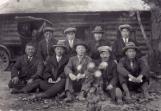14
Denbei Kobayashi and family1918
Okanagan Centre, BC
 Credits:
Credits:Sakuji and Sachiyo (Kobayashi) Koyama collection
15
Denbei (L) and Kizo Kobayashi with their families.18
In addition to orchard work, running a business, and raising a family, Denbei and Hiro entertained many visitors from the coast, including the Japanese Consul, and hosted many traditional holiday celebrations and festivals at their home. Every year the Kobayashi family would hold two major celebrations, Hanami and the Japanese New Year. To celebrate the new year, Denbei would order traditional foods from the coast that would be delivered by the SS Sicamous to Okanagan Centre. When the cherry trees blossomed on the Kobayashi property in the spring, the community would be invited to the house for the celebration of the cherry blossom, the Hanami. Hiro would make pink rice cakes, each wrapped in a cherry leaf.19
The Japanese community at Kobayashi Houselate 1920s
Okanagan Centre, BC
 Credits:
Credits:Lake Country Museum, Image #2007.010.004
20
Denbei Kobayashi assisted in founding two community organizations: the Koyukai Friends and Fellowship Association, pictured here, and the Aobakai Haiku Club.The Koyukai Association was formed in 1921. A Japanese-Canadian men's organization, its founders and members assisted the young Japanese men and families moving to the area. In 1922, Denbei Kobayashi replaced Eijiro Koyama as President of the Koyukai, a position he held for thirteen years.
The Aobakai Club was formed in 1922, and consisted of the men and women haiku enthusiasts of the community, led by Denbei Kobayashi. The Aobakai celebrated its fortieth anniversary in 1962, publishing a book of haiku poetry.
Denbei Kobayashi was also very interested in horticulture. He imported many native Japanese plants to Canada, such as the early blossom cherry tree (higan sukura), Japanese peonies (botan), persimmons (kaki), bamboo, butter burrs, coltsfoot (fuki), and Japanese asparagus (udo). Due to the severe winter conditions, the peonies, persimmons, bamboo, and butter burrs did not survive. The early blossoming cherry was reproduced and adorns many parks and boulevards across Canada today.
21
The Koyukai Association1920s
Rainbow Ranche, Okanagan Centre, BC
 Credits:
Credits:Lake Country Museum, Image #2007.010.001
22
Denbei Kobayashi's orchard in Okanagan Centre was planted with 24 acres of apple trees. With no mechanized machinery to help, all the orchard work was done by hand. Horses were used to haul prunings, to pull the sprayer, and to transport apples to the packing house. Here, Denbei and his son Andrew Hiroshi are working in the orchard, Denbei driving the horse-drawn sprayer while his son sprays the fruit. Protective equipment was unknown in those days.Andrew Hiroshi Kobayashi eventually took over ten acres of the family orchards. His sister Ruth Sachiyo and her husband Sakuji 'Sax' Koyama took over twelve acres.
24
The Kobayashi packinghouse was the first independent packinghouse in the community, located at Camp Road in Okanagan Centre.25
The Kobayashi packinghouselate 1920s
Okanagan Centre, BC
 Credits:
Credits:Lake Country Museum, Image #2007.010.003
26
Denbei Kobayashi's house, Camp RoadWinter 1929-1930
Okanagan Centre, BC
 Credits:
Credits:Lake Country Museum, Image #2007.000.021


